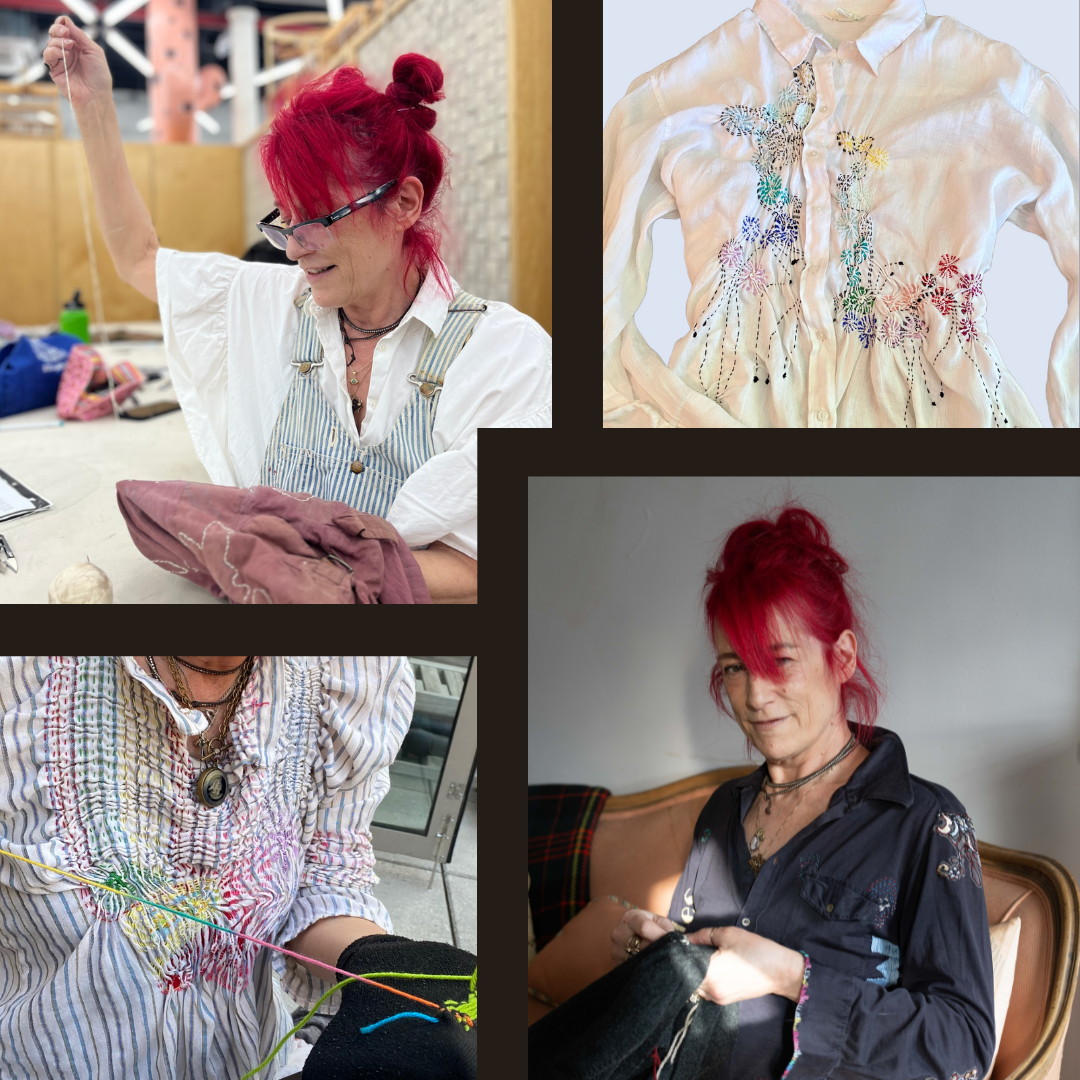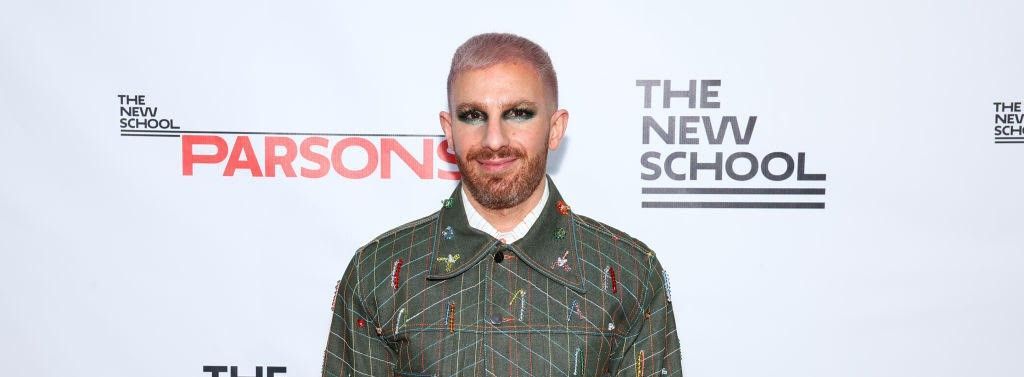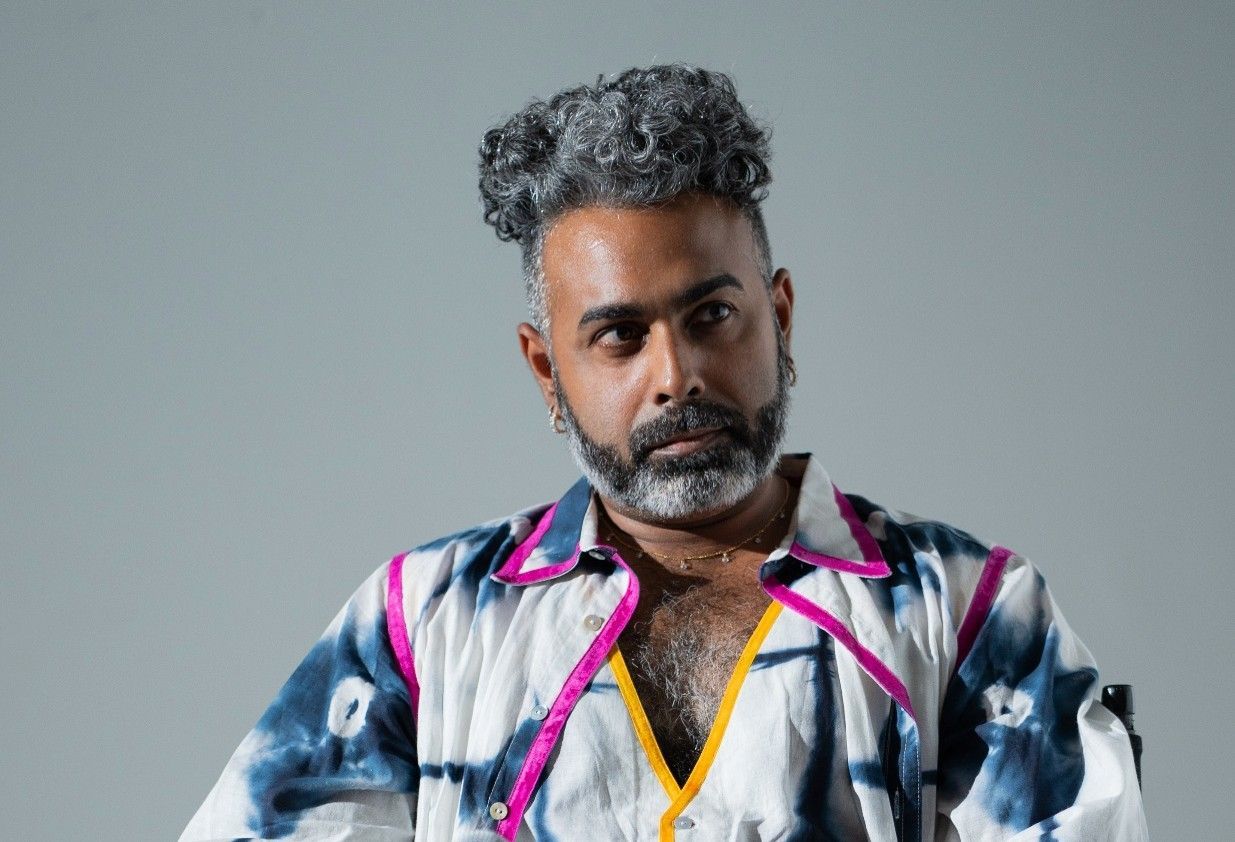Dialogues on Dress: Kate Sekules
This month, we spoke with Kate Selukes, mender, teacher, historian, and more.
The history of dress and the future of fashion act in dialogue, always interfacing to inform our present moment. The Costume Society of America’s diverse members exemplify this reality like no other; through the constant connections across time and disciplines they draw, our membership of costume curators, designers, artists, and so much more embody fashion’s ubiquitous presence - and dress’s daily power to teach us all something new.
We hope you will join us for CSA’s new Dialogues on Dress series, interviews now available monthly in our e-News and here on our website.
Interested in getting in touch? Email enews@costumesocietyamerica.com

Dialogues on Dress: Kate Sekules
Kate Sekules is a master of reinvention. We may know her as the punk pioneer of visible mending, the art of giving worn pieces new life, but her own story is somewhat of a cipher for mending’s enduring lessons. Her “past lives” as the saying goes - as a magazine editor, boxer, musician, and much more - would better be considered as reinventions, new designs, of the same Kate that exudes an aura of play, discovery, and integrity; her jampacked career spanning genres, degrees from drama to costume, and genuine humility and curiosity in conversation are only the half of it. Kate is prolific not just in her literal work, but also in the evolution of her own ideas in the landscape of dress at large. She asks us not to look at mending as a trend, but as a permanent piece in the future of dress, and not to strive for a “circular” system, but one in which we are continually working with what we have, disrupting and innovating, to arrive at a new place altogether. Kate dubs mending “codesign,” reminding the mender that this act is a creative collaboration between you and the garment, one rooted in agency, receptivity, and chiefly, fun. Kate Sekules is an embodiment of the ideas she propagates, speaking with urgency and inspiration while never taking herself too seriously – a necessary quality in maintaining openness and excitement for new ways of being. You can find her teaching across New York City at schools like Parsons, Pratt, and FIT, hosting a monthly mending group at the Textile Arts Center, or playing in her home turf of Brooklyn at secondhand fashion stalwarts like Beacon’s Closet. Wherever it may be, you should probably strive to be there too.
Read our conversation below. This interview has been edited and condensed for clarity.
___________________________________________________
Please paint a brief sketch of your background, personal & professional.
Academia came late in my career; I was a magazine editor, but then magazines were going belly up everywhere. I looked at the writing on the wall and thought “I’ll do what I love most in the world” which is, simply put, old clothes. I started Refashioner, really the first wardrobe trading website. You had to include the story of your item, and then it was curated as well. I discovered how much I love researching old clothes, so I went on to get a Masters from NYU in Costume Studies, [Kate's undergraduate degree was in literature and drama and she is currently pursuing her PhD at Bard Graduate Center], and it has all continued from there. I went into NYU knowing I wanted to concentrate on secondhand circulation or mending. Mending won partly, or really largely, because no one had done it! There is a lot of coverage of contemporary materials, but the history is buried and often unfindable. I teach Fashion History and Mending Fashion, a course of my own invention which involves technical practice; I don’t think you can conceptually understand mending without doing it. I want there to be a discipline called Critical Mending, as I’m hoping this study will grow. I teach all over the place… in corporate and private groups, universities, and as a guest lecturer in classes. There is a new and exciting Masters at Pratt in Sustainable Practices that I’m teaching in as well. For the last 6 or 7 years, I’ve been dropping into university courses to talk about mending cultures, history, etc. My book, Mend!, came out in 2020 – I think it is the only one of the many mending books out there that has history in it.
Why do you think mending is so understudied?
It is very hard to find traces. In order to research mending, you have to go very hybrid and cross many boundaries, which is hard. It is difficult to intrude on these enormous subject areas where I don’t belong, to learn the languages of disciplines like archaeology, anthropology, philosophy, geology… History also, of course, although I am sort of a historian. But I trespass on all sorts of areas of history where I don’t belong. You have to read so much in these other disciplines, and then you end up not using most of it. It is very time consuming, and the seek to find ratio is ridiculous. To discover things about mending you have to swim in all these different pools.
Selfishly, I’m very interested in where mending shows up in literature.
I have actually just been asked to teach a class on mending history in a literature context. Anyone who reads a Victorian novel or really anything pre-20th century and finds a mention of mending, which you often will, will see it is always very instructive. But also, whoever wrote that piece of fiction has the context for mending already, so doesn’t need to overtly explain it. Mending in fiction is very literal and informative only when contextualized. Literature is also actually where you will most often find mentions of something this “quotidian and mundane.”
~In order to research mending, you have to go very hybrid and cross many boundaries, which is hard. It is difficult to intrude on these enormous subject areas where I don’t belong, to learn the languages of disciplines like archaeology, anthropology, philosophy, geology… ~
What is it about “old clothing” that drew you in?
There is a lifeforce in objects of cloth. Many people have written about this, but I have always felt that way without having any technical knowledge. I grew up next to Portobello Road Market in London, and you could find incredible pieces from these piles of clothing; it was a constant history lesson. I read everything I could as a child in the libraries I had access to.
I would love to hear how you would characterize your relationship to dress over the years. How has fashion influenced your work as well as personal journey?
Growing up in London, it is a little looser and there are fewer unspoken rules, so people dress in very interesting and inspiring ways. I have always thought of fashion as a dress up opportunity, and I let that feeling of fun lead me. Also, the turn of the century in London was a great time for design. It all started to go a bit wrong after that, but at the time, sample sales in London were incredible. I had no idea how lucky I was. I can’t say I love fashion anymore though, because of what contemporary fashion means.
The vocabulary (circular, sustainable, etc.) around these topics is tricky. How do you think, on the individual level, we can go about participating in and creating a more circular fashion economy? And what is some better terminology we can use to talk about it?
It absolutely needs to happen on the individual level. Frankly, it is impossible for companies to be circular. Recycling is a total con. It just eats fossil fuel… there is no way for companies to do it in a way that works. We need to think iteratively, lots of little groups and people, by the millions, instead of within this hegemonic, greedy fashion industrial complex. I recently contributed to a book coming out at a later date called
Teaching Fashion Sustainably, and the editors have just asked us for our input on the term “sustainable” - this is evidently a hot topic right now. I do not teach sustainably, I teach disruptively. This word sustainable does not work anymore, if it ever did. It has now been abused and lost all meaning; you can buy a “sustainable” t-shirt from anywhere, it doesn’t mean anything. The word circular is tricky too. I just wrote an article called “Optics of Obvious Mending” in
Fashion Theory [the journal]; I considered a spiral as a better symbol than a circle in thinking about fashion. You cannot connect back to the same place, but with a spiral you can reach a different place on the same circuit. Items and systems can be altered and evolve, never the same as they were before, but still themselves. I am always trying to rethink these ideas and evolve my way of approaching the study of dress, and I would love to be out there more discussing these ideas with others. I do a lot of symposia in the US and other countries, which is a good way to mix it up with other types of academics. But academia can also be very insular, and I would like the conversation to extend beyond. We should all be talking about this, rather than have it locked into strictly economic or academic dialogues.
~I stand behind the term “visible mending” because it conveys the general idea, but it can also sound a bit too trendy. Which is a problem, because trends end. An alternative way to frame it is perhaps “codesign.” There are infinite ways to fix and alter something and add to it, to make it a collaborative process between you and the item. [...] We need to innovate in style and design, and this is a design form. Fashion is fairly moribund and profit-driven, but mending can step in and disrupt that.~
As there are lots of different ways to participate in secondhand fashion, why the focus on mending specifically? What about this practice speaks to you?
I have always mended; it was just something you did growing up. At some point, decades ago, I started doing it in bright or contrasting colors, or just to make it more exciting, and I was interested in the idea of showing the age. Recently, this has become more of a thing. The term visible mending had already been invented, but it was a less popular concept at the time I launched my, somewhat rubbish, original Visible Mending website about 10 years ago. Visiblemending.org [a second website] is part of my dissertation – it is a crowdsourced mending map, and anyone can apply and be on it, but this project is very much still in the works. When I started working on this, I could not believe how little research was out there about mending, and the more I learned the more I discovered I had to learn. I had very supportive professors and tutors at NYU who made me feel like I was onto something. Shoutout Elizabeth Morano!
My mother taught me to sew, but I think mending really teaches itself. My thesis [at BGC] is actually called a “History and Theory of Mending,” to be totally pretentious but try to cover a lot of ground. My idea is that mending is an innate ability, and there is not much really to teach. There was a pedagogy era, but it really has not been formally taught that much if you take all of history. You do mending because you have to. It teaches you. There is mending done throughout history, out of necessity, and mending that we do now, which is performative in a good way. It is a statement we are making about what fashion is. I stand behind the term “visible mending” because it conveys the general idea, but it can also sound a bit too trendy. Which is a problem, because trends end. An alternative way to frame it is perhaps “codesign.” There are infinite ways to fix and alter something and add to it, to make it a collaborative process between you and the item. Mending shouldn’t follow a model or all look the same because people will get tired of that. We need to innovate in style and design, and this is a design form. Fashion is fairly moribund and profit-driven, but mending can step in and disrupt that.
~It is intimidating to put holes in things, you feel like your clothes are somehow not yours to do that to and you are not allowed to approach. But you are. ~
Describe a typical day of work or studies (& perhaps some leisure) - or if no day looks the same, describe a good one.
If I do not immediately start working on my dissertation, I can allow the day to just go off into admin. So, if I can, I write first. My days are also filled with teaching, which right now is in fashion history and also studio technologies & reparative practices at Pratt. On Sundays once a month, I co-host the group Darn It! at Textile Arts Center in Brooklyn with Martina Cox, a brilliant artist, and Hekima Hapa, the founder of Black Girls Sew. We are a fun trio! Typically, about 60 people show up, and about half are people that have never been before. We follow a very loose structure and are each other’s teachers. Anyone is welcome and can just show up (though they should reserve, it sells out); people have made friends for life there, it is really a lovely atmosphere. I mend of course, and in March I mend ALL the time as I run Mendmarch, a mending challenge on Instagram. Otherwise, I have a husband, daughter, and three cats that I spend time with! I live in Brooklyn, and worship at the altar of Beacon’s Closet - a buy sell trade store - so I might spend some time there, and swap out some of my 2,000-piece vintage collection! I strongly believe sharing is the future of clothes. I have always done clothes swaps with my friends, and now twice a year I co-host a swap called Dress-Go-Round.
What advice do you have for someone with no experience, or intimidated by, mending?
You do not need to be formally taught mending, but you should learn how to sew. You can have very basic sewing skills, running stitch will get you wherever you need to go, and there are a lot of resources to learn this, whether online or from all these teachers popping up in person. Check a community board or join a group – I think it is great to join a group. Get some friends together, learn from and encourage each other, and use each other to get through those initial, intimidating stages. Spread the mend – it is contagious! There is no set pattern or way, so surround yourself with people that are going to encourage rather than stifle you. My book actually holds your hand through that. It is intimidating to put holes in things, you feel like your clothes are somehow not yours to do that to and you are not allowed to approach. But you are.
~ I do not believe in whipping people, because it is not working. We need positive incentives, something fun and exciting to participate in, where you feel a sense of agency and creativity in getting dressed. ~
What does the future of fashion look like to you?
I wrote about this at the end of my book, Mend!, and a lot of it is coming true. I would like there to be constant iterations, for everyone to feel like they can alter their own clothes. A wardrobe is not a fixed thing, it is malleable and fluid, coming in and out of your life. We should have secondhand, alteration, and mending workshops and swapping shops, people using old clothes to make new clothes. Billions of clothes are going to waste and filling the earth, but I won’t go on with that topic - I do not believe in whipping people, because it is not working. We need positive incentives, something fun and exciting to participate in, where you feel a sense of agency and creativity in getting dressed. We should feel playful, like we are codesigning with our own clothes.
___________________________________________________
Thank you so much to Kate Sekules for having this conversation with me! You can find her on social media here to stay up to date on her work and teaching. Watch a CSA Conversations on Dress with Kate here. Join her Punk Smocking class at the Tatter Textile Library on November 6th or her monthly group Darn It! at the Textile Arts Center in Brooklyn!
~Madison Brito Taylor
Images (clockwise from top right):
Kate’s punk smocking on a white linen shirt
Photo by Liisa Jokinen
Kate mending at BGC
Photo by Jessica Marquez



